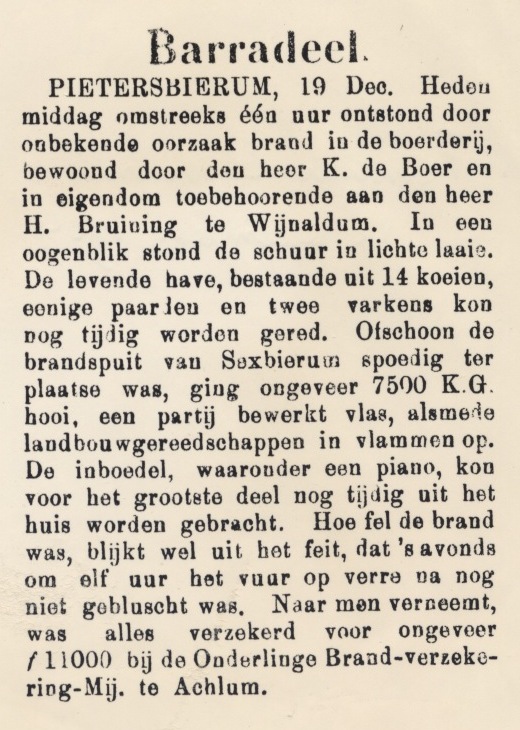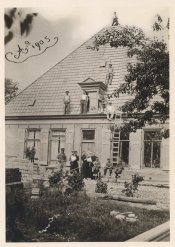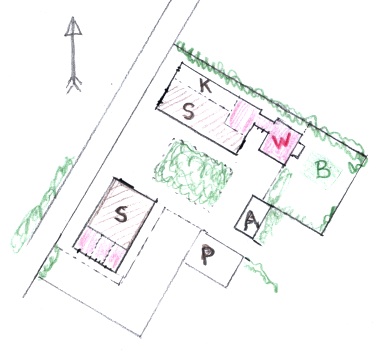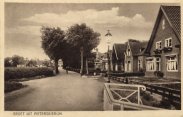|
|
How Pietersbierum looked like in those years has been described in "The road taken by Ynze and Klaas from the farm to school and back in 1880 photos".
Ynze and Klaas grew up together. Next to the school activities they both played "kaatsen" (a frisian team sport with a small hard ball). Both won prizes there (see the clips). And they had of course their chores on the farm.
In 1895 their father Sjoerd died. The estate was described, but nothing much changed because Ynze and Klaas, with mother Lieuwkje, now shared the responsibility for the farm. However, news about Ynze and Klaas playing "kaats" stops.
The plan was that Ynze, the elder son, would take over the farm in 1898.
A sale is announced, in March, to sell the moveable goods in order
to fairly split the value of the possessions between the brothers.
Also real estate is auctioned
(see
ads and documents).
But four months later Ynze died.
He had been engaged to Trijntje (Nynke) Samuels Schuiling (*1874),
orphan daughter of Samuel R Schuiling,
who had been raised by her aunt
Nynke de Jong Schuiling and older cousin
Elisabeth de Jong in Sexbierum.
Trijntje's name also appears in the death advertisement (see
newspaper)
in the Leeuwarder Courant.
Now Klaas had to manage the farm all by himself
(mother Lieuwkje had become rather invalid due to a stroke).
Klaas soon married (likely earlier than originally planned)
Nynke Hoogland, on 19-05-1900.
Trijntje Gelsche Hoogland (*1876 on the farm "Overzicht", Oude Bildtzijl) was always called Nynke (the frisian form for Trijntje). Nynke had become orphan at the age of 9 and had been raised by her uncle and aunt Dirkje D de Jong and Auke Lettinga (Dim and Aukom) in Sexbierum.
Right with the marriage, they also file their wills.
Klaas bought parts of the farm for himself
(see legal documents).
So Klaas and Nynke took over the responsibility for the farm
(see map, Nr: 2) in 1900.
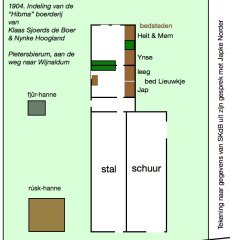
|
In 1904, Klaas and his wife Nynke with their son Ynze lived on the farm, together with Klaas his mother (Beppe) Lieuwkje (Heerkes Hibma). The farm had been from her parents and she had been born there.
The farm had the classical shape: a barn with stables and the living quarters were the extension of the stable (see sketch). The farm was with its rear to the road Pietersbierum-Wijnaldum. The entry to the house was from the side through the kitchen but one could enter also directly from the stable. Everybody slept in bedsteads.
Beppe Lieuwkje had already for some time a limp arm, likely due to a stroke. And she had become incontinent; she therefore had been advised to drink little. She had her own, separate bed in the in-between room, where Jap (her mainstay; see Fire 1904), who had her bedstead there too, could easily help: changings and such. Lieuwkje was in bed often, or she sat in a chair with a shawl around her back.
February 1909 the third child, Sjoerd, was born in the front room. Six weeks thereafter Nynke died from "sepsis" and Klaas stayed behind, alone, with 3 young children. SKdB: Then came "old Grietje" (the mother of Ate Travaille), who was midwife, first as help "omdat sa'n lyts bêrntsje earst fersoarging noadig hie!" (because such a little baby needed much care!)
Children of Klaas and Trijntje G Hoogland:
1900 Ynze (x Tite van der Veen), 1905 Auke (x Tjitske Oosterbaan),
1909 Sjoerd (x A Frieda M T Jager).
The names of the three sons have a well defined origin.
Ynze was named after Klaas' brother Ynze Sjoerds who had died young
(the name Ynze is also frequent in the ancestry).
Aukes name derives from Auke Lettinga
and so is a tribute to the stepfather of Nynke Hoogland
(Aukom and Dim tried to prevent this naming in favour of
a name from Trijntje Hoogland's family; the letter on that matter survived).
Sjoerd is named after Klaas' father.
Then, in 1910, Uncle Gerrit Y de Boer (*1840, +03-09-1921) stopped with the farm on the Âlddyk. He had turned 70 and his sister Aafke had died (*1833, +22-12-1910). After consulation with the landowner, Klaas could follow in the lease on 28-03-1911 (150 pm; see map above: 5). [ Was Klaas all to willing to leave the stjelp, the farm where he had endured so much misery? ] There is, of course, a sale (see Gerrit stops).
Klaas had for the household and the care for the three sons maids, but that did not work well.
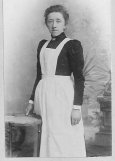
|
On 31-10-1912 Klaas married Trijntje (Nynke) Samuels Schuiling (*1874), former fiancee of his brother Ynze. It is said the marriage was her initiative (one knew each other well). Nynke had become, after Ynzes death, "Diacones" in Leeuwarden (see photo at right from about 1905). Thereafter she had taken care of her Uncle Ds Klaas Schuiling (+1907) and Aunt Bauk (+1912) in Veenwouden and was there alone after both had died. This Nijnke, later mostly called "second mem", was well educated, an endearing woman with character. SKdB: Nynke Schuiling was educated, to the advantage of the raising and guiding of the children. And: They would have loved to have children together, too, but that did not come to pass.
Klaas and Nynke II were from 1911/12 - 1929 on the farm, the "Pleats" on the Âlddyk.
SKdB:
Visitors to the "Pleats" were foremost
Gerke and Doetje Hibma (son of aunt Klaaske Hibma),
Klaas and Jetske (de Boer), and Hyltje and Hanna (de Boer),
and frequently the children of "Jentje-Om" (Hoogland).
And when there was in spring milk from the sheep one made
"skjipke tsyskes" (sheeps cheese). Of these,
the first was always given to Aukom and Dim,
the second to Gerlof and Jo (in Sexbierum),
the third to schoolmaster Faber,
the fourth to uncle Klaas and Aunt Jetske
(in their house at the bottom of Pietersbierum),
the fifth to cousin Hyltje and Hanna.
Klaas focussed on the new farm (with a now "complete" family) and the quality of the farm products. Between 1912 and 1917 he received several prizes for high quality seeds (see clippings).
Around 1920 it becomes of interest to get electricity for the farm.
Klaas enters the board of the "Coöperatieve Vereniging
Electra in Barradeel" (Coop to get electric power to Barradeel).
They try to convince the stakeholders
in the municipality's gasworks in Tzummarum.
Councillor B. van der Mei (for the S.D.A.P.) supports him.
But only by the end of the 1920s will the villages Tzummarum,
Sexbierum and Pietersbierum be connected to the grid
(see "electra").
However, already in 1921 did the Coop Electra deliver electricity
to Wijnaldum and the Hornestreek (where Klaas' farm was).
Klaas then installed an electromotor on a block of concrete in the barn.
With this he could, e.g., run in the barn
a simple threshing machine (driven with belts).
And he bought an electric potato sorting machine.
Klaas was also on the Board of the "Waterschap De Riedpolder" (Board for the waterlevel and sea defence).
In the mean time, the sons grow. Ynze joins in the kaats game and is mentioned in the newspaper. All sons get a decent schooling (see studies).
|
In 1922 Aunt Jetske Post died, since 1917 widow of Uncle Klaas Ynzes de Boer. After many years on their farm in Sexbierum they lived as pensioners in the house at the bottom of the Pietersbierumer mound on the road to Wijnaldum. Klaas manages the estate. He inherits, among other things, that house.
Klaas was a good farmer. He started with nothing, had mishaps, but became one of the "largest" farmers of the "Bjirmen" (the villages Pietersbierum, Sexbierum, Oosterbierum). The landlord needed money
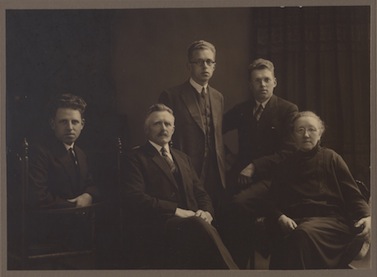
|
In about 1928, a family portrait was made (photo, from left: Ynze, Klaas, Sjoerd, Auke, Nynke).

|
In 1926 Klaas bought his first car, a T-Ford.
The licence plate was registered on 26-3-1926
for Klaas S. de Boer, Pietersbierum, municipality Barradeel,
licence plate
![]() .
.
In 1929, son Auke (aged 24) planned to marry Tjitske Oosterbaan,
implying he liked to succeed on the farm as well.
Because Klaas always got along very well with Auke (said SKdB),
Auke did indeed succeed soon (with permission of the owner of the farm),
with participation of Klaas.
|
The farm on the Âlddyk had the following lay-out
(see sketch; and photos from 1966, SdB).
|
|
Klaas and Nynke II went to the village of Pietersbierum in a new house
at the bottom of the Walburgastraat (see photo) in 1930.
It was built by brother-in-law Gerlof Miedema
(married to Johanna Gelsche Hoogland),
the municipal carpenter and successor to Auke Lettinga.
SKdB: Klaas found it difficult to be retired (it was rather too early).
But he went most every day on bike to the farm to help (in accord).
He then also did some horse breeding.
The farm had, in the years of economic crisis, problems
but the situation improved considerably by the end of the 1930s.
|
At home, Klaas had his vegetable garden.
And Klaas and Nijnke often visited relatives.
In 1937 they celebrated their 25th anniversary,
not in Pietersbierm but with son Sjoerd and wife Frieda,
who resided in Switserland for health reasons.
Having returned home Klaas said:
"Switserlân is moai, mar it is nearne moaier as op e
seedyk in Pitersbjirrum"
(Switserland is beautiful, but is is nowhere as nice as
on the sea dike of Pietersbierum).
When, during WW II, cars were to be confiscated,
the T-Ford was disassembled and the parts were hidden under the
straw in the barn of the farm.
After the war, Klaas rode the car again with pride.
But soon he limited himself to the bike.
That bike had a special feature for getting on:
on the left side of the rear axle was a pin he could put his foot on.
The children and grandchildren often came to the farm. Especially at Christmas and New Year everybody was there, the adults talking about the reults of the year, such as the harvest (Auke), notary public events (Ynze) and the medical practice (Sjoerd).
Klaas was slender, about 1 m 75 tall. He stayed that way all his life. Nijnke gained weight in the course of her life; she always was a loving mother and "beppe" (grandma).
Nynke II had a stroke in 1957 and died two months thereafter, on 18 januari 1958, in the hospital in Harlingen, without having regained conciousness.
Klaas stayed in his house and the maid (Griet Vis) now did even more than before. Until the end of his life, Klaas ate his soup and the porridge with the same spoon, the "birth spoon" of the family. The soup had to be served bubbling hot in the soup-plate. "Derfoar is't waarm iten" (that is why it is the hot meal).
In that geboortelepel the following sequence of generations
was engraved:
SY*1769, YS*1803, KY*1835, KS*1873 (and now also further generations).
This spoon did not go always to the oldest son because not SY*1830
but KY*1835 (the younger son Klaas) received this spoon.
However, this Klaas Ynzes
and his wife Jetske stayed childless and
the inheritance went for a good part to KS*1873.
[Part of the inheritance was the house at the entry of Pietersbierum
where Klaas and Jetske had retired (photo above);
that house was later passed on to Auke Klazes.]
The spoon was not always handed over at birth but mostly later,
then engraved with the correct initials and year of birth.
That spoon is now with a later Klaas.
|
|
April 1959 Klaas again let two lots of land in the "Fjouwerkant" at the Achlumerdijk to the SE of Harlingen to his faithful labourer Pieter Post, who lived in the middle dwelling in the stjelp (the signiture is from that lease).
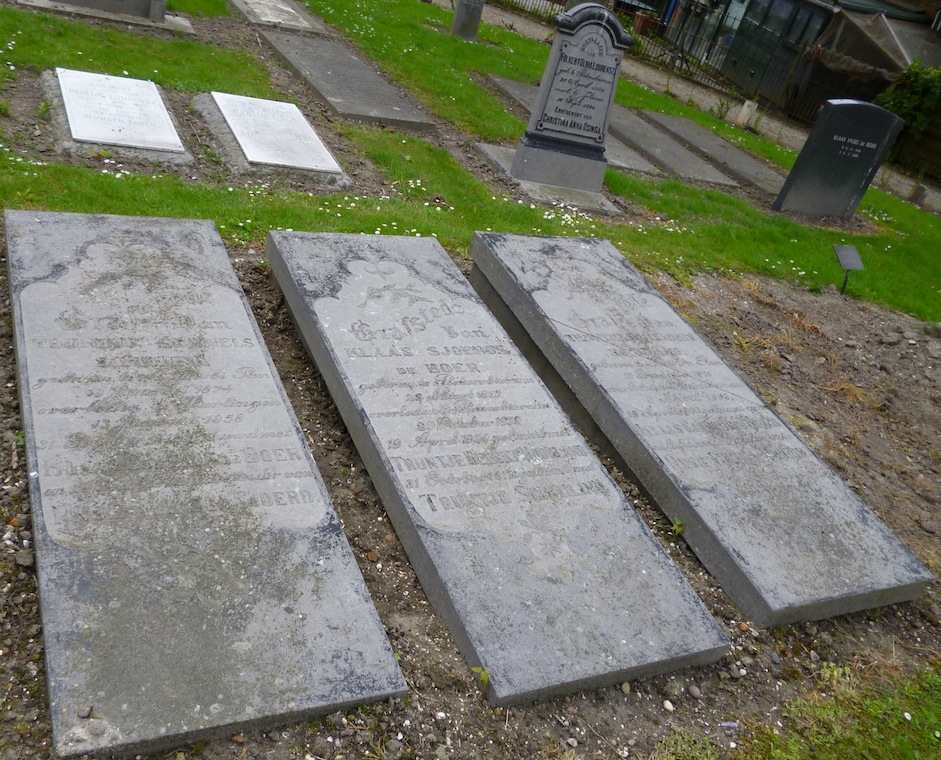
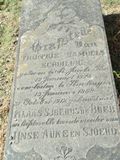

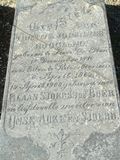
|
October 1959, Klaas died from pneumonia.
He was interred between his wives in the churchyard of Pietersbierum.
The two white stones above the graves of Nynke Schuiling and Klaas
mark the location where schoolmaster Wynsen Fabe and his wife
Reintje Lourensz were burried (Reintje at left, Master at right).
The grave of Folkert Lourensz, the son from the first marriage
of Klaas his mother can be seen above the grave of Nynke Hoogland.
[ Photo at left: KSdB; 3 photos at right: archive Oud Tzummarum.]
To the ads and clippings.
Can one describe the personalities of Klaas and his family?
KSdB: Pake was very nice to his grandchildren.
But he did not talk much.
I do not remember him ever talking
about his youth and his first farm with the fire.
SKdB: Heit was somewhat emotional.
He never went to the churchyard because he feared his emotions
when near the grave of his first wife.
And he could not talk well about difficult matters.
"Tweede mem" was very caring, loving, yet firm.
She has been a great support and life companion for Klaas.
Frieda (wife of SKdB), in 1980,
in a conversation with grandson Klaas Sjoerds:
Klaas had a strict day rhythm (a.o., noon meal at 12 sharp).
He read newspapers thoroughly.
And he was quite upset when his wife Nijke Schuiling went
to visit her relatives for a few days.
Later in life he had skin cancer at his ear.
He took "sour drops" (for what?) and had a hernia.
There was a period where he had a nervous tic;
during the meal he would suddenly reach his hand backwards.
And from hearsay about Ynze, Auke and Sjoerd:
all three looks after their true mother Nijnke Hoogland.
SKdB: memories by son Sjoerd of his parents.
JEB and JOB: Jan-Erik and Jan-Ole Baars, at Vierssen.
*) Waether forecast in the newspaper (NvhN) of 18 December 1904
(see clip).
**) The stjelp built in 1905 is now (2014) falling apart.
The building is, however, a
"monument".



